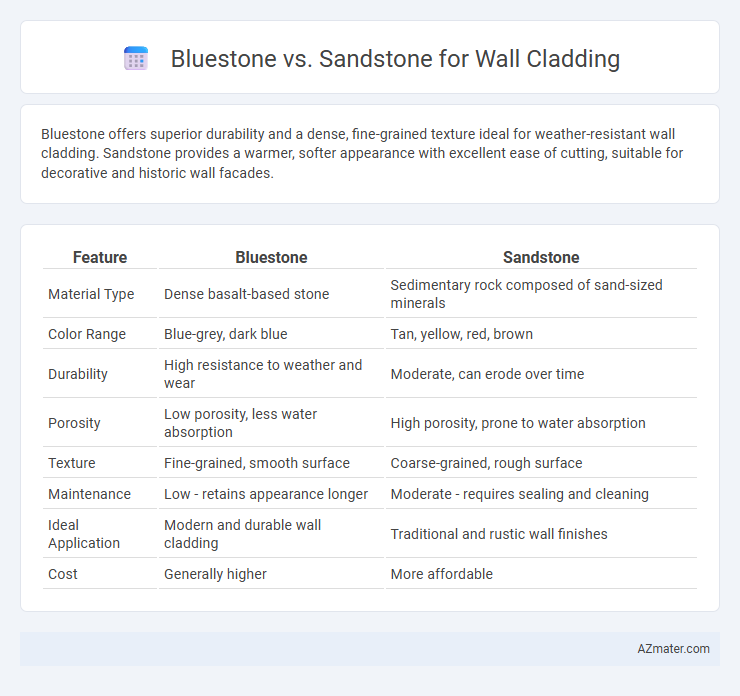Bluestone offers superior durability and a dense, fine-grained texture ideal for weather-resistant wall cladding. Sandstone provides a warmer, softer appearance with excellent ease of cutting, suitable for decorative and historic wall facades.
Table of Comparison
| Feature | Bluestone | Sandstone |
|---|---|---|
| Material Type | Dense basalt-based stone | Sedimentary rock composed of sand-sized minerals |
| Color Range | Blue-grey, dark blue | Tan, yellow, red, brown |
| Durability | High resistance to weather and wear | Moderate, can erode over time |
| Porosity | Low porosity, less water absorption | High porosity, prone to water absorption |
| Texture | Fine-grained, smooth surface | Coarse-grained, rough surface |
| Maintenance | Low - retains appearance longer | Moderate - requires sealing and cleaning |
| Ideal Application | Modern and durable wall cladding | Traditional and rustic wall finishes |
| Cost | Generally higher | More affordable |
Introduction to Bluestone and Sandstone Wall Cladding
Bluestone and sandstone are popular natural stone options for wall cladding due to their durability and aesthetic appeal. Bluestone, known for its dense composition and deep blue-gray hues, offers enhanced weather resistance, making it ideal for exterior applications. Sandstone displays a warm, earthy palette with a porous texture that provides excellent breathability and a rustic charm to both interior and exterior walls.
Key Features and Aesthetic Appeal
Bluestone offers a dense, fine-grained texture with consistent blue-grey hues, making it highly durable and resistant to weathering, ideal for modern, sleek wall cladding designs. Sandstone features a more porous structure with warm, earthy tones ranging from beige to red, providing a rustic and natural aesthetic that enhances traditional or coastal architectural styles. Both stones vary in hardness and maintenance needs, with bluestone requiring less upkeep and sandstone offering greater textural variety for creative facade applications.
Durability and Weather Resistance
Bluestone offers superior durability and weather resistance compared to sandstone, making it ideal for exterior wall cladding in harsh climates. Its dense, fine-grained composition provides enhanced resistance to erosion, moisture absorption, and temperature fluctuations, reducing risks of cracking and spalling. Sandstone, while aesthetically appealing, is more porous and susceptible to weathering, requiring additional sealing and maintenance to ensure longevity.
Maintenance Requirements
Bluestone wall cladding typically demands less maintenance due to its dense composition, which resists staining and weathering better than sandstone. Sandstone, being more porous, requires regular sealing and cleaning to prevent moisture absorption, mold growth, and surface erosion. Proper upkeep of both materials ensures durability, but bluestone offers a more low-maintenance option for exterior wall applications.
Cost Comparison: Bluestone vs Sandstone
Bluestone typically costs between $10 to $25 per square foot, making it a mid-range choice for wall cladding, while sandstone ranges from $15 to $30 per square foot, often reflecting its premium quality and durability. The installation cost for bluestone is generally lower due to its uniformity and ease of cutting, whereas sandstone's variability can increase labor expenses. Considering long-term maintenance, bluestone requires less upkeep, potentially reducing overall expenditure compared to sandstone.
Installation Process and Challenges
Bluestone offers a dense, durable option for wall cladding but requires specialized cutting tools and skilled labor due to its hardness, increasing installation time and cost. Sandstone, being softer, is easier to cut and shape on-site, reducing labor intensity but demands careful handling to avoid chipping or erosion during installation. Moisture absorption differences mean bluestone typically requires less sealing, while sandstone may need additional waterproofing measures to prevent long-term damage.
Environmental Impact and Sustainability
Bluestone offers higher durability and requires less frequent replacement, reducing long-term resource consumption compared to sandstone. Sandstone, often quarried with less environmental regulation, may lead to greater habitat disruption and higher carbon emissions during extraction. Choosing bluestone for wall cladding supports sustainability by minimizing ecological footprint through enhanced longevity and lower maintenance needs.
Popular Design Applications
Bluestone offers a sleek, modern appearance with its dense texture and range of blue-gray tones, making it ideal for contemporary and minimalist wall cladding designs. Sandstone, renowned for its warm, earthy hues and natural grain, suits rustic and traditional aesthetics, providing a timeless look in both interior and exterior walls. Architects often select bluestone for urban projects and commercial buildings, while sandstone is preferred in residential and heritage restorations due to its classic appeal.
Pros and Cons of Bluestone for Cladding
Bluestone offers exceptional durability and weather resistance, making it ideal for exterior wall cladding in diverse climates. Its dense composition ensures low porosity, reducing moisture absorption and minimizing the risk of damage from freeze-thaw cycles. However, bluestone can be more expensive than sandstone and requires professional installation due to its hardness and weight.
Pros and Cons of Sandstone for Cladding
Sandstone for wall cladding offers excellent durability, natural aesthetic appeal, and a wide range of earthy colors, making it ideal for enhancing architectural designs. However, sandstone is more porous than bluestone, which can lead to increased susceptibility to weathering, staining, and moisture absorption if not properly sealed. Maintenance requirements and variable hardness may impact long-term performance, especially in harsh climates or high-traffic areas.

Infographic: Bluestone vs Sandstone for Wall Cladding
 azmater.com
azmater.com